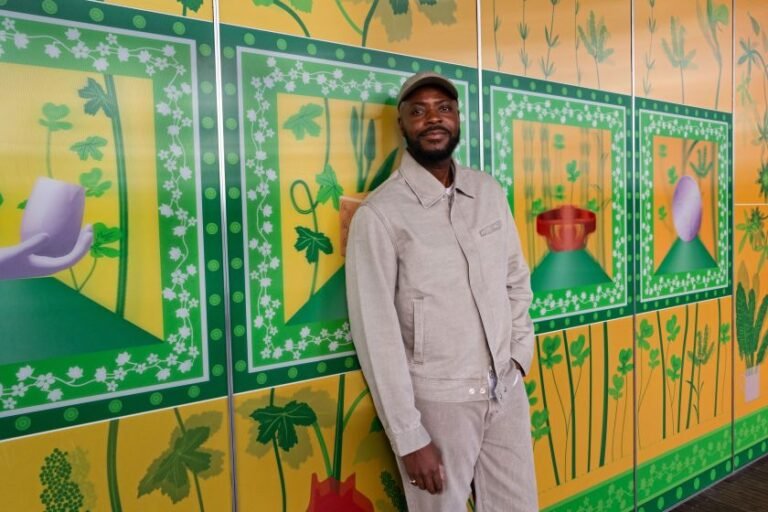

‣ For Studio International, writer and curator Yasmeen Siddiqui excavates the layered political dimensions of the work of artist Lee Bul, whose headless sculptures are currently standing sentinel outside The Met:
In the 1990s, Lee began a body of work, a counterpoint to the soft, fabric sculptures that speak of internal bodiliness. Her Cyborg and Anagram series have been described as doppelgangers, but I prefer to understand them as counterpoints within a whole, as opposed to a mirroring or twin. Cast silicone, polyurethane filling and paint pigment. Extenuated, pointed breasts, nipples erect, an arm gesturing forward with an open palm, fingers ready to grasp hold, a singular leg, muscles activated, ready to spring forward, a hip socket accentuated by a flaring that suggests clothing that shapes into a clam shell, this hyper-feminised figure suggests regeneration.
Lee has used mother-of-pearl because of its property as a material that is self-generated by the mollusc to heal wounds. However, the cyborg is headless, and without a connection to the brain there can be no true integration of the natural human body and its artificial augmentations. The work is a conundrum that pushes well beyond a straightforward thinking about how science and technology are impacting what it is to be human, or gendered. By deciding to allude to cybernetic bodies as headless, Lee has pushed us to think about power and politics.
‣ Sam Needleman of the New York Review of Books spoke with luminary writer Nell Irvin Painter about art history and how she views the field’s evolution:
In everyday life in departments and institutions, I fear that American social habits still afflict historians who are Black, female, and/or Other, especially in the slights and burdens that wear us down and keep us exhausted, in part because we are called upon to assuage the same slights and burdens as they affect our students and colleagues. Such hidden costs are nearly everywhere in American life. And the times we’re in now impose fear. The Trump era’s attack on diversity is already cramping academic lives and scholarship; this MAGA meanness of spirit is doing lasting damage.
But so much has changed for the better! Historians now have access to new and rich archives that simply did not exist decades ago. They can ask and answer questions we could hardly have imagined in the twentieth century. Elite White men have lost their place as the unquestioned protagonists at the center of history. Women’s history, sneered at in the 1970s, long ago went mainstream. The labor history of the 1980s, which focused attention on poor and working people, has influenced historical writing as a whole.
‣ Novelist Viet Thanh Nguyen is saying the quiet part out loud in a new LitHub essay, which explores the inherently imperial nature of American literature. He explains:
Writers of color have always written about this surreal contradiction between lofty ideals and brutal realities, which prevents the possibility of a universal humanism. This contradiction is vividly illustrated by the genocidal Israeli attack on Gaza, using bombs and political cover provided by Biden and continued by Trump in a bipartisan display of American imperial power. In the name of protecting the Jewish people, the Palestinians are reduced to what multiple Israeli government officials have called “human animals,” an obscene term that simply repeats how Western colonizers have always seen the non-white, colonized peoples whom they slaughtered in the name of civilizing them. The Palestinians and those who support them are the exception to Western Civilization and American Exceptionalism, but to even point this out is punished with increasing ferocity, from censoring, firing, doxxing, and arresting to expulsion and deportation.
The contemporary American literary world is in disarray as a result. While many writers are sympathetic to Palestinians, many of their literary institutions have been flummoxed, unable to support Palestinians, name genocide, or use the active voice to identify Israeli agency, even as many writers demand that they do. These literary institutions are a part of empire, supported by the state or by powerful donors who benefit from the imperial machinery.
The genocide in Gaza is therefore not an incidental event that can be ignored but a fundamental event like the Vietnam War, where what is being burned with American weapons are not just nonwhite people but American ideals and the possibilities of euphemism. In the light of that fire, American imperialism is revealed, as well as the complicity of Americans who do nothing, including writers who say nothing.
‣ Them‘s Samantha Riedel reports on the UK Supreme Court’s recent heinous ruling constricting gender identification for trans people to “biological sex,” sparking outrage and expressions of support for trans communities around the world:
Although the Court allowed outside testimony from anti-trans groups such as the nonprofit Sex Matters — and even praised Sex Matters’ legal counsel Ben Cooper KC for providing “focus and structure to the argument that ‘sex,’ ‘man’ and ‘woman’ should be given a biological meaning” — no trans people were allowed to weigh in on the appeal. The Court denied a formal request last year by the Good Law Project to accept testimony from trans legal experts Dr. Victoria McCloud and Prof. Stephen Whittle. “[W]e think it was wrong of the Supreme Court to decide not to hear from any trans voices, even though they’re the only ones whose rights are on the line,” representatives for the Project wrote at the time.
The Edinburgh-based advocacy group Scottish Trans wrote that its members were “shocked and disappointed” by the ruling in a press release Wednesday, saying the Court’s decision “undercuts the central purpose of the Gender Recognition Act” and goes against 20 years of equality law in the U.K.
“This judgement appears to have limited the scope of gender recognition so that trans people’s gender will no longer be recognised in many circumstances,” Scottish Trans representatives wrote, adding that they will “continue working for a world in which trans people can get on with our lives with privacy, dignity and safety.”
‣ A bright spot in the storm of this week, Tracy Chapman spoke with critic Lindsay Zoladz of the New York Times about the reissue of her beloved hit “Fast Car,” telling her own story, and growing up a reader:
I know you read a lot as a child, and are still an avid reader. You’ve said that writers inspired you more than other musicians when you were starting out.
I still stand by that. I think there’s some assumption with me that I’m coming out of the ’60s folk tradition. You can slot me in there, but it wasn’t my foundation. I wasn’t aware of that music in Cleveland in the ’70s, as a young Black girl. It just wasn’t on my radar. As the youngest in the family, I also never had control of the stereo. And I didn’t have any money, so it wasn’t like I was going out and buying records. I listened to the radio all the time. I listened to Casey Kasem’s Top 40 countdown, and I used to record it, actually, on a little steno tape recorder.
But I grew up across the street from a public library, and it was the only place my mom would let me go on my own. I loved books, but to be able to do anything alone when you’re a kid, you’re going to take that opportunity. It was my second home, and I read everything that I could get. I especially loved poetry. People like Nikki Giovanni and Gwendolyn Brooks and Rudyard Kipling. I’d take out anthologies and I had a little notebook, and if there was something I really liked or felt inspired by, I would write the part of the poem out. I think I quoted Nikki Giovanni for my high school yearbook. My other quote is a little embarrassing: Father Guido Sarducci, because I loved “Saturday Night Live” and thought he was an awesome character.
‣ Elon Musk and X are undoubtedly cursed to the core. But I fear Wired‘s Ashwin Rodrigues makes a point about the emerging alternative, Bluesky: It’s decidedly unfunny. But, he explains, there is a path forward for people who want to engage with social media in healthier ways:
“The internet old timers would be very frustrated, because the new people didn’t know the social norms,” says technologist, writer, and former WIRED contributor Anil Dash. “Exactly the phenomenon we’re seeing right now.” September, for the most online netizens, was a dreaded time of the year. AOL opened the floodgates, allowing anyone to access the internet at any time. AOL’s bloom coincided with the Telecommunications Act of 1996, which deregulated the telco industry and brought internet connectivity to homes and institutions across the US.
This period was called the Eternal September, with “wave after wave of newbies getting online,” Dash says.
The pattern has repeated itself with LiveJournal and even Twitter. Actor and investor Ashton Kutcher appeared on CNN in 2009 and challenged the network to see whose account could hit 1 million Twitter followers first. (Kutcher won.) The stunt led to a rush of users flooding the microblogging platform.
Lubchansky thinks this moment presents an opportunity for people to examine their reply etiquette.
“Read the whole post before you respond. Take a moment to respond. And if you’re going to respond with a joke, and we’re not friends already, go look and see if somebody’s made it already,” Lubchansky says. “Because there’s a really good chance they have.”
Meanwhile, Brown considers the block function on Bluesky to be a favor to its recipient.
“If someone comes into my comments and they just really, really don’t understand, usually I just block them so we don’t run into each other again,” she says. “No hard feelings.” It’s a different approach than the norm on X, where quote-tweets viciously insulting the original post are part of the platform’s noxious fabric.
‣ This one’s for all my former marine biologist wannabes — a team of researchers in Miami is working on a biomorphic, textured seawall that may be able to keep water at bay and house tiny organisms at the same time. Florida International University’s Sara Pezeshk and Shahin Vassigh explain their design in the Conversation:
Unlike the flat, lifeless surfaces of typical concrete seawalls, each BIOCAP tile is designed with shaded grooves, crevices and small, water-holding pockets. These textured features mimic natural shoreline conditions and create tiny homes for barnacles, oysters, sponges and other marine organisms that filter and improve water quality.
The tile’s swirling surface patterns increase the overall surface area, offering more space for colonization. The shaded recesses are intended to help regulate temperature by providing cooler, more stable microenvironments. This thermal buffering can support marine life in the face of rising water temperatures and more frequent heat events driven by climate change.
Another potential benefit of the tiles is reducing the impact of waves.
When waves hit a natural shoreline, their energy is gradually absorbed by irregular surfaces, tide pools and vegetation. In contrast, when waves strike vertical concrete seawalls, the energy is reflected back into the water rather than absorbed. This wave reflection – the bouncing back of wave energy – can amplify wave action, increase erosion at the base of the wall and create more hazardous conditions during storms.
‣ Phone a friend but it’s literally ChatGPT:
‣ Library workers across the US right now:
‣ This audio really is the gift that keeps on giving:
Required Reading is published every Thursday afternoon, and it is comprised of a short list of art-related links to long-form articles, videos, blog posts, or photo essays worth a second look.


